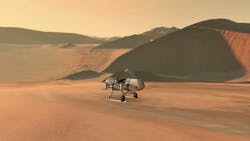Burying CAESAR: how NASA picks winners -- and losers -- in technology development for space exploration
WASHINGTON – The planetary science community rippled with euphoria in June when Dragonfly, a bold mission to send a nuclear-powered dual quadcopter to Saturn’s largest moon, Titan, was given the green light by NASA. Scientific American reports. Continue reading original article
The Military & Aerospace Electronics take:
25 July 2019 -- Yet even as the Dragonfly team erupted in celebration at the news, those working on its competitor, the Comet Astrobiology Exploration SAmple Return (CAESAR) mission, mourned.
If the CAESAR space exploration project ever launches, it will be many years after Dragonfly, much later than its proposers had planned; more likely, in its current form, it will never be built at all.
Years of technology development efforts and staggering amounts of work hours go into a typical planetary-science mission proposal, and for each one “you don’t know if you’re wasting your time, or even your career,” says Dante Lauretta, a member of the CAESAR team at the University of Arizona.
Related: NASA offers to partner with industry to develop advanced fuel cell technology for space
Related: Crystal Group contributes technology to NASA’s Space Video Gateway system
Related: NASA reaches out to industry for ideas on next-generation small satellite technologies
John Keller, chief editor
Military & Aerospace Electronics

